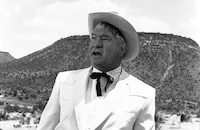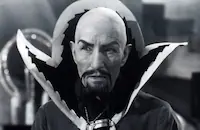Allegheny Uprising

Brief Synopsis
Cast & Crew
William A. Seiter
Claire Trevor
John Wayne
George Sanders
Brian Donlevy
Wilfrid Lawson
Film Details
Technical Specs

Synopsis
In 1759, Jim Smith and his friends, MacDougall and the Professor, return from fighting the Indian wars in Quebec to their home in Pennsylvania's Allegheny Valley. There they are welcomed by MacDougall's fiery daughter Janie. That night, Indians attack a nearby settlement, and Jim leads a contingent of settlers disguised as Indians to rout the marauders. Realizing that the Indians are acquiring their weapons from local traders, Jim rides to Philadelphia to request that the British governor order a trade ban with the Indians. General Gage consents to Jim's request, thus infuriating Callendar, a crooked trader who circumvents the ban by persuading an army clerk to issue permits to him. When Captain Swanson, the smug British officer in charge of the territory, refuses to believe Jim's accusation that Callendar is continuing to supply the Indians with rum and munitions, Jim and his men, once again disguised as Indians, attack the wagon and destroy the contraband. The wily Callendar, however, outsmarts Jim by destroying the army wagons and accusing the settlers of treason. When Swanson believes Callendar's accusations, Jim decides that the only way to prove the trader's treachery is to allow the contraband laden wagons safe passage to the fort, then seize the fort and send a wagon of trade goods to General Gage as proof. To eliminate Jim, Callendar frames him for murder, but his trial comes to an abrupt halt when General Gage arrives, orders Callendar's arrest and sends Swanson back to England.

Director

William A. Seiter
Cast

Claire Trevor

John Wayne

George Sanders

Brian Donlevy

Wilfrid Lawson

Robert Barrat
John F. Hamilton

Moroni Olsen

Eddie Quillan

Chill Wills

Ian Wolfe
Wallis Clark
Monte Montague
Olaf Hytten

Clay Clement
Eddy Waller
Carl Knowles
Ethan Laidlaw
Forrest Dillon
Earl Askam
Bud Osborne

Charles Middleton
Clive Morgan
Jess Caven
Crew
Pandro S. Berman
Anthony Collins
George Crone
Albert D'agostino
Kenneth Holmes
Nicholas Musuraca
Walter Plunkett
Van Nest Polglase
David Robel
Darrell Silvera
Bob Watson
Earl A. Wolcott
P. J. Wolfson
P. J. Wolfson

Videos
Movie Clip



Trailer
Film Details
Technical Specs

Articles
Allegheny Uprising
Truth be told, Allegheny Uprising has its flaws but is still an entertaining film. The plot moves along quickly and economically, making up for a lack of depth in the characters. Plus, it's always intriguing to watch actors like John Wayne, Claire Trevor, Brian Donlevy and George Sanders play variations on their distinctive personas. (Was there ever an actor better at conveying contempt than George Sanders?)
Allegheny Uprising is set in colonial Pennsylvania before the Revolutionary War. Local settlers are outraged that their people are being killed by Indians using guns sold by white traders, and they convince the British commanders to outlaw trade with the Indians. The businessmen don't like this, however, and surreptitiously include some weapons and rum in a military wagon train delivering supplies to a fort. (As one businessman whines, "What's the government for if not to protect business? Certainly not to interfere with it!") The settlers find out about the scheme, and Jim Smith (John Wayne) leads a group of men disguised as Indians to ambush the wagon train. Now it's time for the traders (led by Brian Donlevy) to complain to the British, and an effete, by-the-book British officer (George Sanders) is sent to guard the supply wagons at all costs.
This story is based on a true incident and is interesting as a depiction of the kinds of tensions which led to the Revolutionary War. Unfortunately, the movie had a few outside factors working against it. One week before it opened, John Ford's better Revolutionary War-era movie, Drums Along the Mohawk, was released. Furthermore, WWII had just broken out in Europe, so it was not the best timing for a movie critical of the British.
Claire Trevor is top-billed over Wayne, a sign that for the moment anyway, she was still a big star and Wayne hadn't quite arrived yet - this despite the fact that Stagecoach had been released eight months earlier. Stagecoach marked Wayne and Trevor's first pairing, and in that landmark picture they underplayed their romance effectively. In Allegheny Uprising, Trevor is rather shrill, though that's likely due more to the script and director than to her skills. (Director William Seiter, while experienced, was no John Ford.) Still, Wayne and Trevor make a good team. Trevor's spunky energy essentially makes her worthy of Wayne, much like his later leading ladies Maureen O'Hara or Angie Dickinson. The duo would team up once more, in Dark Command (1940).
Brian Donlevy was nominated for a Best Supporting Actor Oscar® in 1939 - not for this film but for Beau Geste. The Oscar® went to Thomas Mitchell for Stagecoach. George Sanders' role in Allegheny Uprising was originally to be played by Sir Cedric Hardwicke. Sanders stepped in when Hardwicke did The Hunchback of Notre Dame (1939) instead.
Producer: P.J. Wolfson
Director: William A. Seiter
Screenplay: P.J. Wolfson, Neil H. Swanson (novel)
Cinematography: Nicholas Musuraca
Film Editing: George Crone
Art Direction: Van Nest Polglase
Music: Anthony Collins
Cast: Claire Trevor (Janie MacDougall), John Wayne (James Smith), George Sanders (Capt. Swanson), Brian Donlevy (Trader Ralph Callendar), Wilfrid Lawson (Mac MacDougall), Robert Barrat (Magistrate Duncan).
BW-81m. Closed captioning.
by Jeremy Arnold

Allegheny Uprising
Quotes
Men, we've fought and won. But in winning we have lost something. In defending one law, we've come to despise all law. And if you go on like this, we'll destroy the very thing we fight for.- The Professor
If you're going to hang, I'll hang with you. That's the least you can let me do.- Janie MacDougall
They're real friendly like, the injuns.- Trader Ralph Callendar
The only friendly Indians are dead Indians, I say.- 'Mac' MacDougall
Put that gun down!- James 'Jim' Smith
I won't! I'm not going to be a widow before I'm even a wife.- Janie MacDougall
Trivia
Notes
The working titles of this film were Pennsylvania Uprising and Allegheny Frontier, and it was released in Britain as The First Rebel. According to a pre-production news item in Hollywood Reporter, actor Bob Burns was slated to appear in this picture but withdrew over a disagreement about the story. Another news item in Hollywood Reporter notes that George Sanders replaced Sir Cedric Hardwicke in the role of Capt. Swanson when Hardwicke left the film to fill the spot intended for Basil Rathbone in The Hunchback of Notre Dame. Other news items in Hollywood Reporter add that the film was shot on location at Lake Sherwood and Sherwood Forest, CA. This was the second of three films that paired John Wayne and Claire Trevor in 1939 and 1940. The first was Stagecoach and the third was The Dark Command.

Miscellaneous Notes
Released in United States 1939
Released in United States on Video May 31, 1989
Re-released in United States on Video May 9, 1995
Released in United States 1939
Re-released in United States on Video May 9, 1995
Released in United States on Video May 31, 1989














